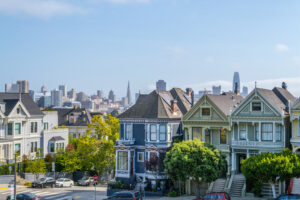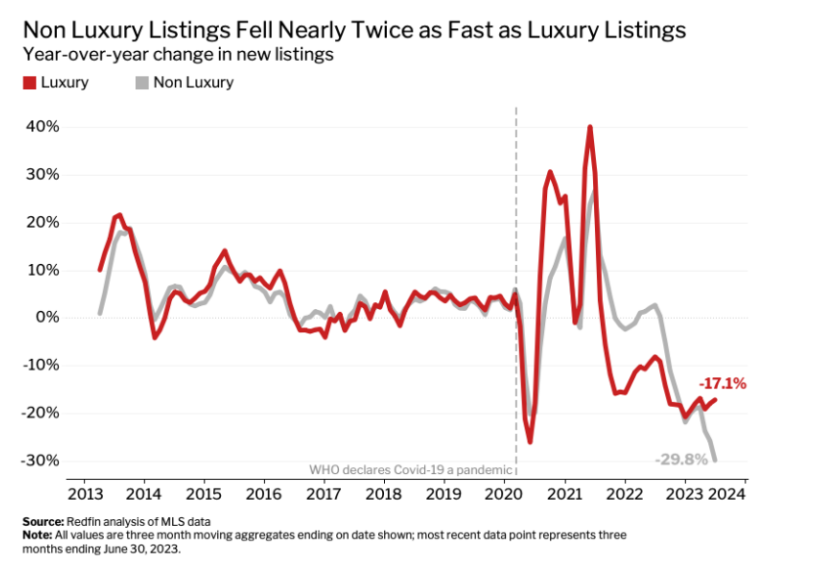 Redfin reports that nationwide, luxury sale prices were still higher than they were last year, with the median sale price of luxury homes rising 4.6% year-over-year to a record $1.2 million in Q2. By comparison, the median sale price of non-luxury homes climbed 1.5% to a record $340,000. While homebuyer demand has slowed across the board this year, prices are being propped up by a lack of inventory, which is fueling competition in many markets.
Redfin reports that nationwide, luxury sale prices were still higher than they were last year, with the median sale price of luxury homes rising 4.6% year-over-year to a record $1.2 million in Q2. By comparison, the median sale price of non-luxury homes climbed 1.5% to a record $340,000. While homebuyer demand has slowed across the board this year, prices are being propped up by a lack of inventory, which is fueling competition in many markets.
Luxury home prices in San Francisco are falling faster than anywhere else in the nation, according to Redfin, as the median sale price of luxury homes in San Francisco fell a record 12.7% year-over-year to $4.8 million in Q2—the largest decline among the 50 most populous U.S. metropolitan areas. While $4.8 million may not sound like a bargain, it is compared with the $5.5 million record high hit just one year ago.
“Buyers are getting big discounts on high-end condos in San Francisco right now—especially those under 1,000-square feet,” said local Redfin Premier Real Estate Agent Ali Mafi. “Those homes are having trouble selling, and some sellers are losing a lot of money.”
Three other pricey West Coast tech hubs also saw double-digit declines in the median sale price of luxury homes, as in Seattle, luxury sale prices decreased a record 12.3% to $2.5 million—the second biggest drop in the country, followed by Oakland, California (-11.1% to $2.8 million), and San Jose (-10.3% to $4.3 million).
Luxury housing prices in expensive coastal areas have taken a relatively big hit because those markets were already among the most expensive in the nation, meaning prices had more room to fall. Additionally, Redfin found that tech hubs have been disproportionately impacted by stock-market declines and tech layoffs, which have diminished buying power for high-end house hunters. In San Francisco, increasing housing supply is also likely contributing to the drop in prices; the metro was one of just three that saw new listings rise in Q2. But the stock market’s recent rally and easing recession worries, along with declining prices, may be starting to bolster high-end home purchases. Luxury sales in San Francisco fell just 4% year-over-year in Q2—a smaller drop than any other major metro—following more than a year of double-digit declines.
East Coast markets experienced the largest price increases with New Brunswick, New Jersey reporting the median sale price of luxury homes rising 12.1% year-over-year to $1.8 million—the largest increase among the 50 biggest metros. New Brunswick was followed by Charlotte, North Carolina at 9.2%; Newark, New Jersey at 9.2%; Orlando, Florida at 8.8%; and Virginia Beach, Virginia at 7.8%.
New listings of luxury homes fell 17.1% year-over-year Q2, while those of non-luxury homes plunged a record 29.8%.
“High mortgage rates are prompting many middle-income homeowners to stay put, but wealthy homeowners can often afford to move even if it means taking on a higher rate and monthly payment,” said Redfin Chief Economist Daryl Fairweather. “Wealthy buyers are also more likely to pay in cash, meaning they’re less likely to be deterred by elevated mortgage rates.”

Luxury listings are also holding up relatively well due to an increase in homebuilding. Newly built homes tend to be more expensive, meaning they often fall into the luxury tier. With so few people listing homes, builders are cashing in on being the only game in town.
Nationwide, the total number of luxury homes on the market fell just 2.4% in Q2, the smallest decline since 2020, while non-luxury supply plunged a record 18.8%.
Redfin found that luxury home sales fell 24.1% year-over-year in Q2, and while that is a substantial decline, it is the smallest reported in a year. Non-luxury sales dropped 19.4%. The decrease in home sales has eased across the board, as Americans have grown accustomed to high mortgage rates in excess of 6.5%, bringing some buyers off the sidelines. The gap between luxury and non-luxury sales is shrinking; at the start of the year, luxury sales were down a record 42%, while non-luxury sales were down just 31.4%.
Luxury sales have consistently declined more than non-luxury sales over the last year because people tend to purchase fewer expensive goods during times of economic uncertainty, but the gap is likely narrowing in part due to an improving stock market and easing recession fears.
“Normally when the housing market is hurting, it’s the luxury market that’s hurting the most by far, but today’s market is unusual because there isn't a recession,” Fairweather said. “While a lot of high-end homebuyers remain on the sidelines, many of the ones who are in the market are still willing to spend big.”

 DSNews The homepage of the servicing industry
DSNews The homepage of the servicing industry









